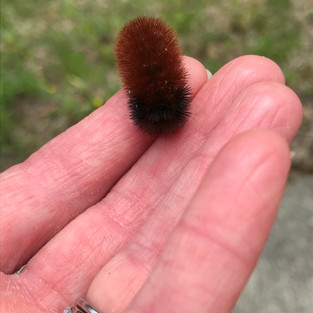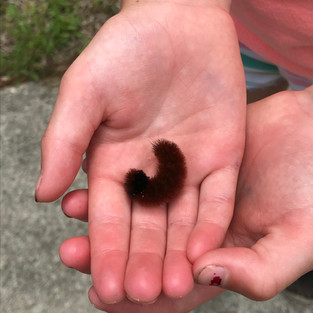CRITTER SPOTLIGHT: Banded Wolly Bear: Pyrrharctia isabella
- cynthiamorissette
- May 31, 2020
- 2 min read
Good Morning Watershed Explorers,
The critter spotlight for this week is the banded woolly bear caterpillar. The banded woolly bear becomes the Isabella tiger moth. The moth is beautiful, but I have a soft spot in my heart for the cute, little, furry caterpillar. These docile little creatures look like little furballs. Upon picking them up, similar to pillbugs, they will often curl up into a tight ball. Here are a few pictures of the banded woolly bear, and one of the adult moth!
The woolly bear caterpillar used to be considered a weather predictor. Entomologists (scientists who study insects) have since found this to be untrue, but folklore said that if the banded woolly had a large orange band that winter would be mild and if the band was small the winter would be harsh. Whether a weather predictor or not, it is still rather incredible that this little creature can have so many variations of color. In the pictures above, the curled up woolly is entirely black, while the other has a small black band while the rest is dark orange.
Habitat:
Banded woolly bear caterpillars and Isabella tiger moth adults are found near marshes, meadows, and forests. The caterpillars like moisture and extensive ground debris where they can hide.
Diet:
Isabella tiger moths feed on nectar from wildflowers. Their mouthparts are similar to a straw.
Banded woolly bear caterpillars have chewing mouthparts and will eat dandelions, clover, birch leaves, maple leaves, and other grasses.
Watershed Role:
As you can probably tell, woolly bears are not water creatures. However, they still play an important role in the watershed food chain as they provide food for other creatures.
I am not one to promote keeping wild critters as pets, but many people do raise woolly bear caterpillars into moths. Woolly bears are actually one species of caterpillar that hibernates. Here is a brochure that explains how to raise a woolly bear. The life cycle on the brochure is great. https://www.cambridgebutterfly.com/wpcontent/uploads/2017/12/woolly_bear_brochure.pdf
I hope you enjoyed learning about the banded woolly bear. If you have an idea for a future critter spotlight, please go to the www.nbcwatershedexplorers.com webpage and email me from the green button at the bottom of any of the pages with your ideas!
Much love Watershed Explorers,
Mrs. Morissette
















Comments